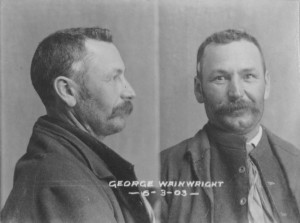A photo of two thylacine (Thylacinus cynocephalus) carcasses suspended from a hut in Waratah, Tasmania, has intrigued students of the animal’s demise. Who killed these tigers? Eric Guiler speculated that they might have been taken by a Waratah hunter John Cooney who collected two government thylacine bounties in 1901.[1]
In fact the photographer, Arthur Ernest Warde, was himself a hunter and future Woolnorth ‘tigerman’, and the photo probably depicts his own kills. The man in question was a wheeler and dealer who spent three decades in Tasmania, turning his hand to any useful practical skill—including photography and exploiting the fur trade. The terms of Warde’s stint at the Van Diemen’s Land Company’s (VDL Co’s) Woolnorth property in the years 1903–05 confirm that, far from being specialist thylacine killers, the so-called Woolnorth tigermen were simply regular hunter-stockmen who also took responsibility for managing snares set for thylacines at Green Point near latter-day Marrawah. Given this collision of photographer and tiger snarer, it is tantalising to wonder what tiger-related photos Warde took while working at Woolnorth that may still remain undiscovered in a family scrapbook, or which may have long since mouldered away in someone’s back shed, lost for all time.

Warde’s early life remains as mysterious as his tiger photo. In Wellington, New Zealand in 1890 he married renowned whistler and music teacher Catherine Elizabeth Walker, née Dooley, the daughter of Zeehan shopkeeper Joseph Benjamin Dooley and his wife Annie Dooley.[2] The Wardes, both of whom were known by their middle name, appear to have been in Bendigo in 1891 and by 1893 had relocated to Inveresk, Launceston, where the photographer, ‘late of New Zealand’, presented images of Maori chiefs to the Queen Victoria Museum.[3] The couple’s first child, Winifred Warde, was born at Launceston in 1893.[4]
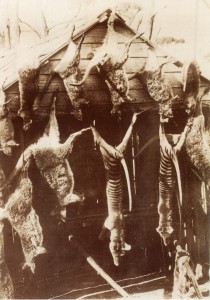
In 1896 the Wardes were in Devonport, in 1897 in Waratah, where second daughter Mabel was born.[5] Elizabeth taught music in both towns.[6] It was supposedly at Waratah that Warde took the intriguing photo, which shows two thylacine and eight wallaby carcasses hanging from the front of a building more closely resembling a woodshed than a hunting hut. The photo slightly pre-dates the era of the skinshed, the unique Tasmanian invention which revolutionised high country hunting by enabling hunters to dry large numbers of skins without leaving the high country. In fact, the photo does not show drying skins, but carcasses which are yet to be skinned. What is the purpose of the image? It is not the conventional trophy photo, which would pose the hunter with his trophy kill. Warde himself collected two thylacine bounties, ten months apart, in September 1900 and July 1901, while living at Waratah, where he probably learned to hunt.[7] Just as the bushman Thomas Bather Moore celebrated in verse the incident in which one of his dogs killed a ‘striped gentleman’, perhaps for Ernest Warde the novelty of killing a thylacine or two justified commemoration or memorialisation of the event with a photo. It is likely that he killed at least one of the thylacines in the photo, and afterwards submitted it for the government bounty.
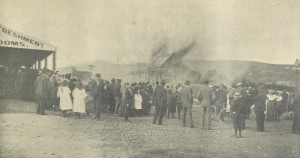
From the Weekly Courier, 1 March 1902, p.17.
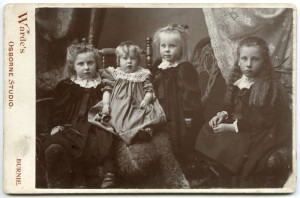
Warde was one of many to have practised photography in Waratah, and with the town’s population still growing, he would not be the last. However, in December 1901 a better photographic opportunity arose in a coastal centre, Burnie, when John Bishop Osborne decided to move on. Warde took over Osborne’s Burnie studio, while also operating a farm at Boat Harbour and advertising his and Elizabeth’s services as musicians.[8] In 1902, while Elizabeth was busy producing the couple’s third child, Francis Harold Warde, photos credited to Warde and to Warde’s Osborne Studio photos appeared in the Weekly Courier and Tasmanian Mail newspapers.[9]
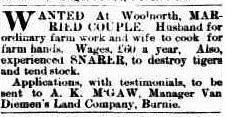
Warde appears to have made the acquaintance of VDL Co agent AK McGaw while supplying photos to the company. The photography business must not have been lucrative, as in May 1903 he agreed to replace the gaoled George Wainwright as the Mount Cameron West tigerman.[10] Warde’s contract as ‘Snarer’ shows him to be a general stockman and farm hand engaged for the Mount Cameron West run, with the killing of ‘vermin’ (that is, all marsupials) his primary duty:
‘It is hereby agreed that the Snarer shall proceed to Mount Cameron Woolnorth … and shall devote his time to the destruction of Tasmanian Tigers, Devils and other vermin and in addition thereto shall tend stock depasturing on the Mount Cameron Studland Bay, and Swan Bay runs, also effect any necessary repairs to fences and shall immediately report any serious damage to fences or any mixing of stock to the Overseer & shall assist to muster stock on any of the above runs whenever required to do so & generally to protect the Company’s interests shall also prepare meals for stockmen when engaged on the Mount Cameron Run’.
The pay was £20 plus rations (meat, flour, potatoes, sugar, tea, salt, with a cow given him for milk) with the snarer providing his own horse.[11] A butter churn was later provided, and farm manager James Norton Smith added that ‘when he wants a change he can catch plenty of crayfish’.[12] No rent was paid for the Mount Cameron West Hut, and the former company reward of £1 per thylacine still applied. In addition, the VDL Co agreed to supply the snarer ‘with hemp and copper wire for the manufacture of tiger snares only (the Snarer supplying such materials as he may require for Kangaroo or Wallaby snares)’.[13] That is, the necker snares used to catch thylacines were stronger than those used to catch wallabies and pademelons. It was the same deal as for his predecessors: the company supplied a small wage and rations, encouraging the stockman-hunter to protect his flock by killing thylacines and keep the grass down by killing other marsupials. In July 1904 Warde advertised in the newspaper for an ‘opossum dog’, which he was willing to exchange for a ‘splendid kangaroo dog’. He knew that the best money was in brush possum furs.[14]
Warde was the last stockman-hunter based at Mount Cameron West. Nearing the close of 1904 he was also trying to ‘get a good line of snares down from the Welcome [?] forest into the back of the Studland bay knolls’, which would give him ‘a splendid tiger break …’[15] However, he had probably already landed the last of his twelve thylacines for the company. In February 1905 the Mount Cameron West Hut was burnt down, Warde’s family escaping the flames late at night in the breadwinner’s absence.[16] That the hut was not replaced for years confirms that the thylacine problem, real or perceived, had abated.[17]
After leaving Mount Cameron West, Ward ditched the ‘e’ from the end of his surname and complemented the Boat Harbour farm with a general store. The Wardes remained there until in 1923 they sold up their store to Hamilton Brothers of Myalla and relocated to New Zealand, where A Ernest Warde reattached his ‘e’ and reinvented himself firstly as an Otago real estate agent, working for his father-in-law, then as an Auckland used car salesman.[18] Elizabeth Warde disappeared from the picture and, appropriately, Ernest wound back his personal odometer to 49 years when in 1932 he took his new 33-year-old bride Mary Winifred Tremewan to see England and America.[19] The new marriage ended when the couple was living in Sydney in the mid-1940s.[20] Warde’s death certificate, in July 1954, described him as an ‘investor’. In truth, he was a trans-Tasman jack-of-all-trades who happened to be the last of the Woolnorth tigermen.[21]
[1] Eric Guiler and Philippe Godard, Tasmanian Tiger: a lesson to be learnt, Abrolhos Publishing, Perth, 1998, p.129. Cooney’s bounty payment was no.249, 19 June 1901 (2 adults, ’11 June’), LSD247/1/ 2 (Tasmanian Archive and Heritage Office [hereafter TAHO]).
[2] For her prowess as a whistler, see ‘Current topics’, Launceston Examiner, 15 January 1894, p.5; ‘Burston Relief Concert’, Daily Telegraph, 16 January 1894, p.3 and ‘Entertainment at the Don’, North West Post, 21 April 1894, p.4. Elizabeth Walker is the mother’s name given on the couple’s three children’s birth certificates. On the 1903 Electoral Roll her name is given as Catherine Elizabeth Warde.
[3] ‘Australian Juvenile Industrial Exhibition’, Ballarat Star, 26 May 1891, p.4; ‘The Museum’, Launceston Examiner, 23 December 1893, p.3.
[4] She was born 31 August 1893, birth registration no.606/1893, Launceston.
[5] In 1896 E Warde of West Devonport advertised to sell a camera, lens and portrait stand (advert, Mercury, 23 May 1896, p.4). In 1897 the Wardes featured in a Waratah dance (‘Plain and Fancy Dress Dance’, Launceston Examiner, 9 October 1897, p.9). Mabel Warde’s birth was registered as no. 2760/1898, Waratah.
[6] Advert, North Western Advocate and the Emu Bay Times, 30 January 1902, p.3.
[7]; Bounties no.293, 18 September 1900 (’11 September’); and no.305, 12 July 1901, LSD247/1/2 (TAHO).
[8] See advert, North Western Advocate and the Emu Bay Times, 6 December 1901, p.4; ‘Table Cape’, North Western Advocate and the Emu Bay Times, 19 November 1901, p.2. John Bishop Osborne, the former Hobart photographer, had been on the move every few years since setting up at Zeehan in 1890. Osborne moved to Penguin, and he would end his days in Longford, where he lived 1921–34. Ernest and Elizabeth Warde advertised that they were available to supply music to parties and balls, while Elizabeth also sought piano, organ and dance students (advert, North Western Advocate and the Emu Bay Times, 30 January 1902, p.3).
[9] Francis Harold Warde was born at Alexander Street, Burnie, on 17 December 1902 (registration no. 2061/1903). Catherine Elizabeth Warde and Ernest Warde were listed at Burnie on the 1903 Electoral Roll.
[10] The new operator of the Osborne Studio was Mr Touzeau of Melba Studio, Melbourne (advert, North Western Advocate and the Emu Bay Times, 27 June 1903, p.1). Warde held a furniture sale at his Alexander Street, Burnie, residence in June 1903 (‘Burnie’, North Western Advocate and the Emu Bay Times, 13 June 1903, p.3) and advertised for a ‘strong quiet buggy Horse and good double-seated Buggy (tray-seated preferred …’ (advert, North Western Advocate and the Emu Bay Times, 8 June 1903, p.3).
[11] For Warde’s proposed rations, see James Norton Smith to AK McGaw, 4 June 1903, VDL22/1/34 (TAHO).
[12] James Norton Smith to AK McGaw, 4 June 1903; Ernest Warde to AK McGaw, 7 October 1903, VDL22/1/34 (TAHO).
[13] Agreement between the VDL Co and Ernest Warde, 29 May 1903, VDL20/1/1 (TAHO).
[14] Advert, North West Advocate and the Emu Bay Times, 26 July 1904, p.3.
[15] E Warde to AK McGaw, 22 December 1904, VDL22/1/35 (TAHO).
[16] ‘Marrawah’, North West Advocate and the Emu Bay Times, 11 February 1905, p.2.
[17] Woolnorth farm journal, 3 February 1905, VDL277/1/32 (TAHO).
[18] ‘Boat Harbor’, Advocate, 31 January 1923, p.4; ‘Bankruptcy’, Auckland Star, 27 September 1929, p.9.
[19] Did Elizabeth Warde die or did the couple divorce? No record of her was found. According to their marriage certificate (registration no.8401/1929), Mary Winifred Tremewan was born in New Zealand in October 1898. For their ten-month English and American holiday, see ‘The social round’, Auckland Star, 6 January 1933, p.9 and UK Incoming Passenger Lists, 1878–1960. They sailed from Sydney to London on the Ormonde.
[20] Record no.1208/1944, Western Sydney Records Centre, Kingswood, NSW.
[21] Warde was not the last man to kill thylacines at Woolnorth, but the last in a long line of hunter-stockmen appointed specifically to Mount Cameron West to look after stock and manage the thylacine snares at Green Point.

